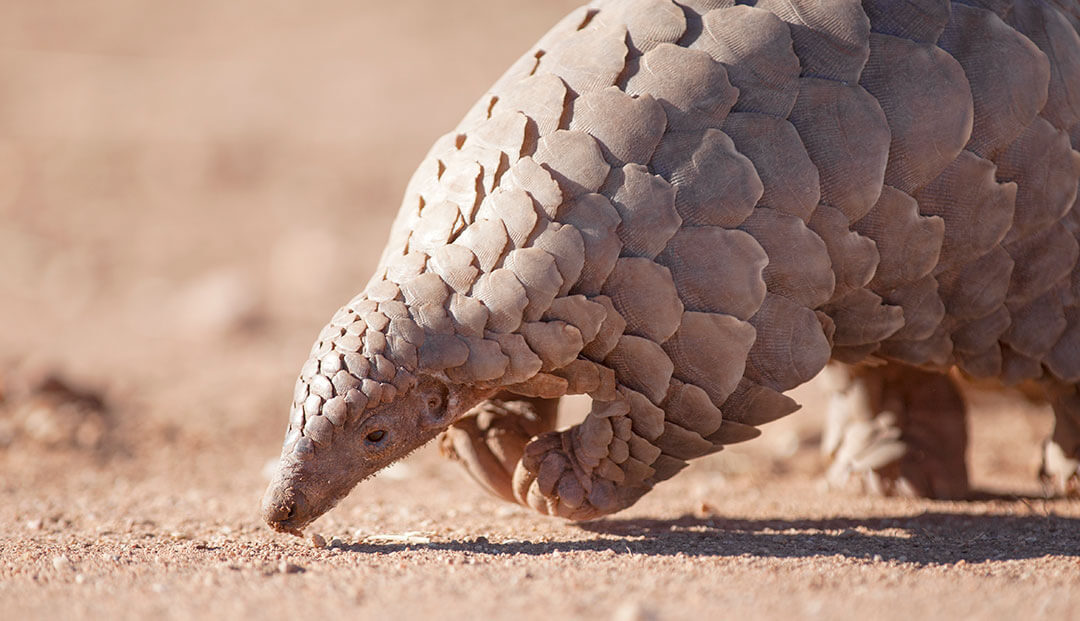The 17th of May is Endangered Species Day. Started in 2006, Endangered Species Day is celebrated each year to raise awareness about the planet’s declining wildlife species.
Created with the intention to raise awareness of how fragile the existence of some animal, insect and plant life is, Endangered Species Day serves as a reminder to the world about protecting the planet’s animal species. It also aims to educate everyone about the factors that have impacted these species’ population declines.
While there are endangered animals around the world, this blog post highlights the five most endangered animals in Africa and the organisations and foundations that are working hard to protect them.
Why We Celebrate Endangered Species Day
We share a world with many wonderful animals, insects, creatures and plants. Many of these incredible species are sadly approaching the risk of extinction.
The ‘endangered’ status of a species is decided by the International Union for Conservation of Nature (IUCN), established in 1964. According to the IUCN, approximately 40% of the world’s animal, insect and plant species are at risk of extinction.
There are several wildlife conservation organisations that take part in Endangered Species Day, often holding events and activities that provide information on how to help fund further conservation. Around the world, conservation experts are dedicating their lives to saving animal, plant and insect species from the prospect of extinction.
Why Species Are Becoming Endangered
There are various reasons for animal endangerment; a large percentage of which is caused by human involvement. From deforestation for agriculture or destruction and habitat loss due to human interference, many animals are losing their natural habitat and are left unable to breed, hunt and survive.
Hunting, overhunting and illegal poaching of animals can push species to the brink of extinction – purely for human enjoyment, satisfaction, consumption or sport. Beyond human involvement, natural disasters and environmental shifts such as climate change impacted by global warming also compromise animal life.
Five African endangered animals
In honour of Endangered Species Day, we have listed five endangered species of African animals that are heartbreakingly listed as endangered species.
Pangolin
There are four species of pangolin found on the African continent, and they are some of the most endangered species in Africa. Globally, all eight species of pangolin are under enormous threat as they are the most trafficked animal in the world. In fact, all eight pangolin species are listed by the IUCN as Vulnerable to Critically Endangered.
In Africa, the pangolin is on the brink of extinction. African pangolins are relentlessly hunted for their scales, which are believed to have ‘medicinal purposes.’ Pangolins are killed and sold on the black market for up to $3000.00 per kilogram – their meat is eaten while the scales are used for alternative health treatments.
The four species of pangolin that live in Africa are:
- Black-bellied pangolin (Phataginus tetradactyla)
- White-bellied pangolin (Phataginus tricuspis)
- Giant Ground pangolin (Smutsia gigantea)
- Temminck’s Ground pangolin (Smutsia temminckii).
The other four species of pangolin live in Asia. For many years, the Asian species were the primary target for poachers. However, as their numbers have significantly decreased, traffickers are increasingly turning to African pangolins.
If you’re unfamiliar with the pangolin, read our collection of interesting facts about African pangolins.
African Wild Dog
The wild dog is one of the world’s most endangered mammals.
Throughout history, African wild dogs have been shot and poisoned by farmers who blame these dogs for hunting their livestock. As well as being killed by farmers who view them as threats, the overall wild dog population is in decline due to habitat loss caused by deforestation and human developments.
The main threat to this species decline is human overpopulation, which leads to habitat fragmentation and increases human-wildlife conflict. There are approximately 3000 – 5000 African wild dogs left in game reserves and national parks across Africa.
Wild dogs are one of the most endangered animals in South Africa, where we have fewer than 500 wild dogs left in the wild. They are generally found in the Kruger National Park and on the odd game farm.
If you’d like to learn more about the painted wolf, read these interesting African wild dog facts.
Ethiopian Wolves
Endemic to Ethiopia, the largest population of Ethiopian wolves can be found in the Bale Mountains. Ethiopian wolves are one of the rarest animals in Africa. At present, there are roughly less than 500 wolves remaining.
These rare African animals have a red-brown coat, with spots of white on their underbelly, chest and chin. Their ears are large and pointed and they sport a long, bushy black tail.
Since 2008, the Ethiopian wolf population has decreased by 30 percent. Humans are the most significant threat to these wild animals in Africa, mainly due to farming and overgrazing of livestock, which overtakes large portions of their habitat. This has forced Ethiopian wolf populations further into the highlands.
Another reason for their endangered African animal status is tied to disease, including consecutive epizootics of rabies and canine distemper, particularly in the Bale Mountains.
Black Rhino
Three of the five species in the rhino are part of the most endangered species in the world, namely the black, Javan, and Sumatran rhinos.
The black rhino is deemed Critically Endangered by the IUCN. Between 1960 and 1995 rhino populations dropped by a staggering 98% due to illegal rhino poaching, taking the species to the brink of extinction.
Today, rhino poaching is a national crisis for South Africa. The species is under major threat due to dangerous poachers and illegal hunters who kill these animals for their horns. Rhino poaching is driven by the demand for rhino horn which is used in traditional Chinese medicine and seen as a symbol of status, wealth and success.
In 2020, 394 rhinos were poached in South Africa, marking a sixth consecutive year showing a decline in poaching. However, even with the decline in poaching, pressure still remains incredibly high to protect this critically endangered species in South Africa, particularly in the Kruger National Park.
As a response to this crisis, there are extensive conservation efforts across Africa to protect the rhinos and increase their populations.
Tip: Read these interesting facts about rhinos to learn more about these horned African animals.
Addax
The addax, a species of antelope found in Niger and Chad, is classified as a Critically Endangered species.
This African endangered species is possibly the rarest hoofed animal in the world, with as few as 100 left in the wild.
The biggest threat to the addax is due to human involvement, such as locals who hunt them without proper supervision. They are slow-moving animals and therefore become easy targets for hunters in vehicles with modern weapons. There are also natural factors such as droughts and desertification that threaten these rare animals in Africa.
There are reintroduction initiatives of the addax in Morocco and Chad, along with management of addax between populations released into three protected areas in Tunisia.
Extinct animals in Africa
Unfortunately, some African animals have already gone extinct.
Here are a few of the extinct African animals:
- The cape lion forms part of the extinct animals in South Africa. It was hunted to extinction by Dutch and English settlers. The last cape lion was killed in 1858.
- The bluebuck was also hunted to extinction by settlers by the beginning of the 18th century.
- The quagga, a subspecies of the zebra, became extinct before a system was put in place to distinguish the species. The last wild quagga was shot in the 1870s.
Organisations Helping the World’s Endangered Species
Various global charities and organisations are dedicated to making our natural world a better place. Many global organisations work tirelessly to support and protect the rarest animals in the world that are at risk of becoming extinct.
If you’re interested in getting involved in the endangered species conservation space, start by learning about the various animals in crisis and connect with the organisations that aim to protect them.
Here is a list of some of the many organisations that help conserve the endangered animals of Africa. We’ve included relevant links so that you can visit their website and follow their social pages.
Tikki Hywood Foundation
The Tikki Hywood Foundation raises awareness about and establishes conservation practices of the lesser-known endangered species focusing on the pangolin. As well as a 24-hour wildlife rescue center that is available to assist emergency cases, Tikki Hywood Foundation runs multiple breeding and release programs for endangered and rare species.
Follow Tikki Hywood Foundation on Facebook, Twitter, Instagram and YouTube.
African Wildlife Foundation
The African Wildlife Foundation aims to ensure that wildlife species and their habitats survive and thrive. Working with wildlife, land and communities, the foundation aims to not only save Africa’s disappearing wildlife from extinction but to conserve their natural habitats as well as empower local communities through eco-friendly education and resources.
Follow the African Wildlife Foundation on Facebook, Twitter, Instagram and YouTube.
International Anti-Poaching Foundation
The International Anti-Poaching Foundation, also known as the IAPF, is an anti-poaching organization operating in southern and East Africa. Through the IAPF, Akashinga, a female-lead anti-poaching operation, sees women in local communities become custodians of the land, working strategically to protect Africa’s endangered animals from the threat of poaching. Proceeds from the organisation are returned to the community.
Follow the IAPF on Facebook, Twitter, Instagram and YouTube.
World Wildlife Fund
This international non-profit organisation works to address urgent global challenges that threaten our planet. The World Wildlife Fund operates across the board in various conservation sectors including wildlife, marine, forests, freshwater, food and climate.
Follow the World Wildlife Fund on Facebook, Twitter, Instagram and YouTube.
Stop Rhino Poaching
Formed as a direct response to the national rhino poaching crisis in South Africa, Stop Rhino Poaching works to protect the lives of Africa’s decreasing rhino population. Stop Rhino Poaching both funds and builds security initiatives across Africa that protect game reserves from illegal poachers and supports rangers on the frontlines.
Follow Stop Rhino Poaching on Facebook, Twitter and Instagram.
International Union for Conservation of Nature
The International Union for Conservation of Nature (IUCN) was the world’s first global environmental organisation. Over 185 countries form part of the union, with thousands of projects around the globe.
They run a Save Our Species project that aims to support threatened species. Endangered African animals that have benefited from their conservation efforts include African elephants, African lions, crocodiles and leopards.
Follow the IUCN on Facebook, Twitter, Instagram and YouTube.
Learn More About the Endangered Animals of Africa
If you’d like to do some further reading about some of Africa’s most endangered species, here are a few great book suggestions. These are great as gifts or educational coffee table books.
- Endangered Animals – Tom Jackson
- Africa’s Wild Dogs: A Survival Story – Jocelin Kagan
- Elephant Reflections – Dale Peterson & Karl Ammann
- Pangolins: Scales of Injustice – Richard Peirce
- Operation Lock and the War on Rhino Poaching – John Hanks
Wrapping Up: Africa’s Endangered Animals
Endangered Species Day is a day to reflect on our actions as humans and the ways in which we as a species can contribute to protecting, conserving and appreciating the many beautiful animals, insects and plants we share our planet with.
We hope that you enjoyed reading this post and that it gave you more information into the state of Africa’s endangered wildlife species. Show your support on Endangered Species Day by checking out one of the organisations above.
If you’d like to learn more about Africa’s wonderful animals and conservation efforts in Africa, have a look at our list of the best documentaries about African wildlife.
Firsy published August 2020, last updated February 2024.

